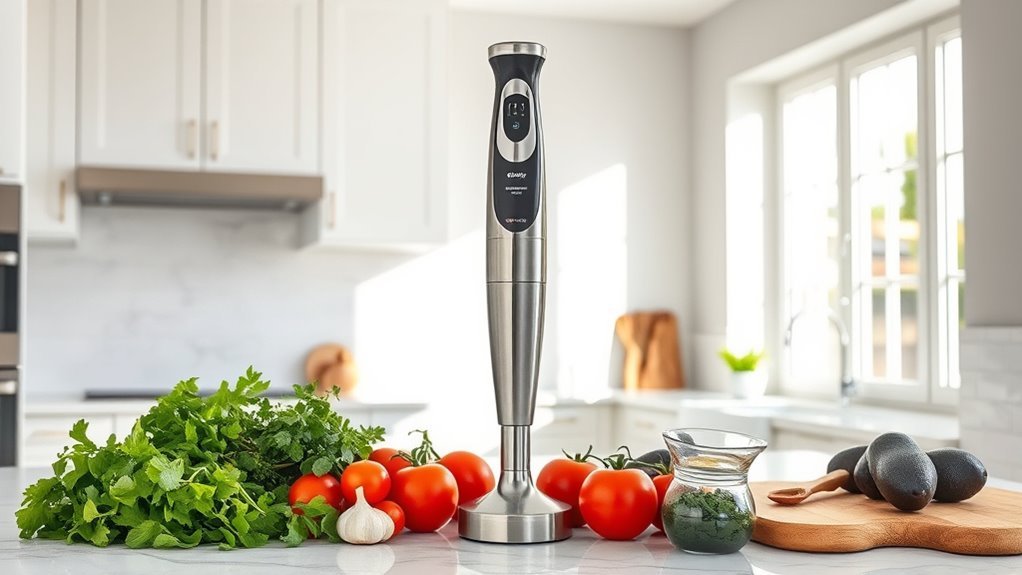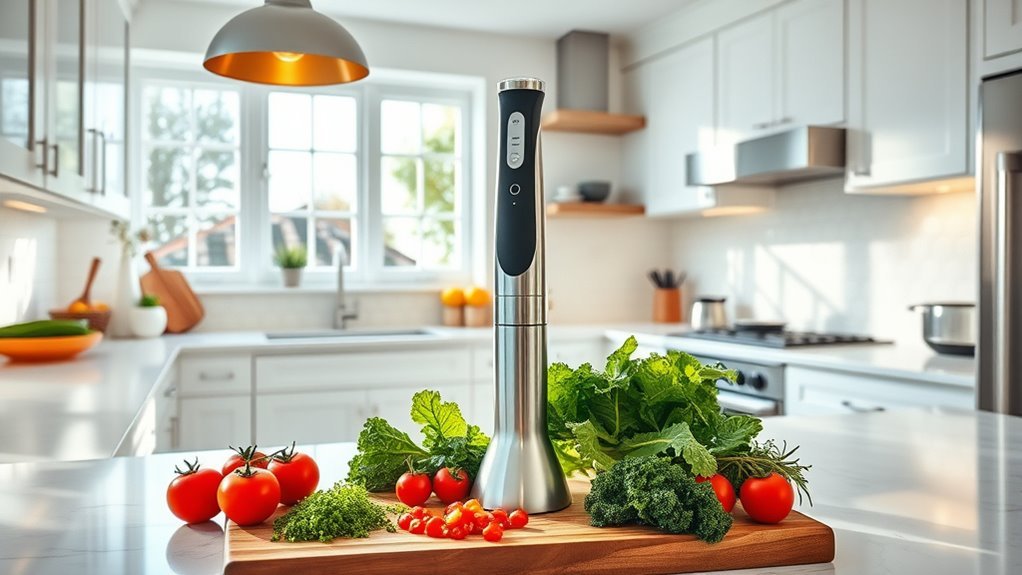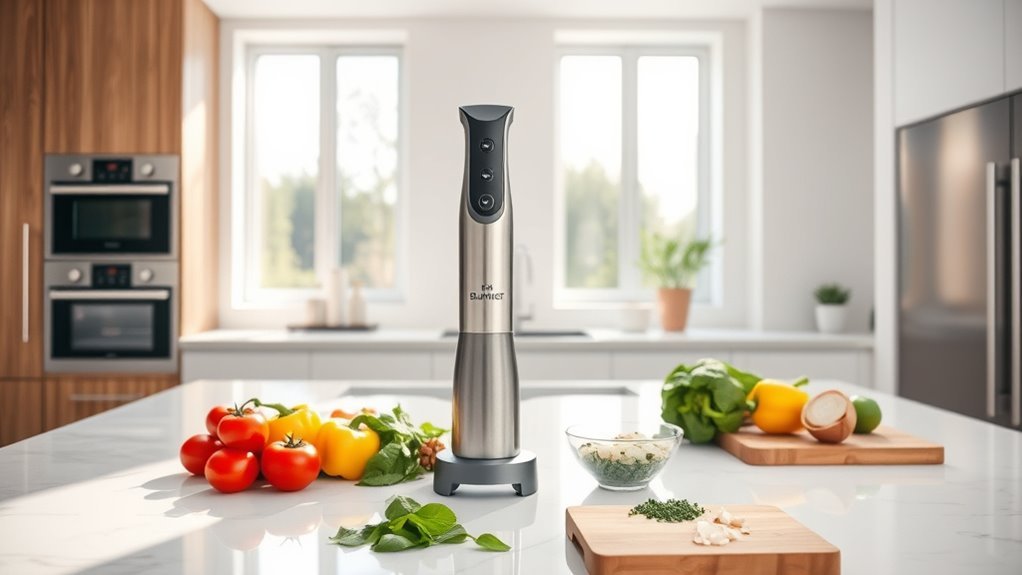When we’re choosing between immersion and countertop blenders, portability often becomes a deciding factor. We’ve all been there—trying to make a quick smoothie while rushing out the door or wishing we could bring our blending capabilities to a vacation rental. The difference between lugging a 15-pound appliance versus slipping a 2-pound wand into your bag can be… well, night and day. But is the more portable option always the better choice for your specific needs?
Design Differences That Impact Mobility

When it comes to mobility, immersion blenders and countertop blenders couldn’t be more different.
Immersion blenders (also called stick blenders or hand blenders) feature a slim, compact design that’s incredibly space-saving.
With models like All-Clad’s 9.25-inch shaft, we’re able to blend directly in various containers without needing extra space.
Countertop blenders, well, they’re kind of stuck in one place.
Their bulky motor base and attached pitcher demand significant counter space and can’t really be moved around easily during cooking.
We’ve found that Kenmore’s immersion blender disassembles into smaller pieces, fitting nicely in a drawer or cupboard.
Most countertop models? They need dedicated storage space.
The narrow profile of stick blenders makes them perfect for kitchens where every inch of counter space matters.
Meanwhile, high-performance blenders often feature larger jar capacities, which further limits their mobility compared to immersion blenders.
Weight Comparison: Why It Matters For Transport
The size difference between these blenders matters, but let’s talk about something that’s equally important—weight. When you’re considering portability, the heft of your kitchen tools makes a huge difference. Immersion blenders, also known as hand blenders, typically weigh under 3 pounds, making them ideal for small kitchens or travel.
| Blender Type | Average Weight | Portability Rating | Best For |
|---|---|---|---|
| Immersion blenders | 1-3 pounds | Excellent | Small batches, travel |
| Cordless hand blenders | 2-4 pounds | Very good | Kitchen mobility |
| Mini countertop blenders | 5-8 pounds | Moderate | Small kitchens |
| Full-size countertop blenders | 10-15 pounds | Poor | Stationary use |
We’ve found that the 70-80% weight difference between countertop and immersion blenders dramatically impacts how—and where—you’ll use them. Trust me, your wrists will thank you! Compared to their counterparts, high-performance blenders often weigh more due to their powerful motors and robust construction.
Space Requirements At Home And On-The-Go

Two critical factors come into play when comparing these kitchen workhorses: how much space they’ll hog at home and whether you can realistically take them anywhere.
When we compare immersion blender vs countertop models, the difference is striking.
Immersion blenders win the space race with their slim profile, easily tucking into drawers—Kenmore’s stainless steel version breaks down into tiny pieces right away.
Countertop blenders, while offering hands-free operation, demand precious real estate in smaller kitchens.
For home chefs constantly on the move, the choice between an immersion blender and countertop model often depends on specific needs.
The two types of blenders serve different purposes—one slips into your weekend bag for impromptu cooking experiences, while the other, well, stays put.
Your kitchen size and lifestyle should guide which best enhances your cooking experience.
Travel-Friendly Features Of Each Blender Type
Packing for a culinary adventure requires thoughtful selection of kitchen tools, and blenders present quite the conundrum.
When comparing types, immersion blenders are known for their exceptional travel-friendliness.
Also called stick blenders, they disassemble into compact pieces that fit easily in luggage.
Many immersion blenders feature rechargeable batteries, making them ideal for blending anywhere without outlets.
Traditional blenders, like Countertop for Smoothies models, just don’t travel well.
These blenders come with bulky bases and large pitchers requiring significant space.
I mean, who wants to lug a 64-ounce container in their suitcase?
Meanwhile, immersion blenders weigh under 2 pounds and blend directly in whatever container you have available.
For travelers who can’t imagine vacation without smoothies or soups, the choice is pretty clear!
Setup Time And Convenience Factors

Beyond portability considerations, setup speed becomes a major factor when you’re rushing to prepare meals.
Immersion blenders shine here with their grab-and-go simplicity, while countertop models require more assembly time.
When comparing different types of blenders, we’ve found immersion models greatly cut down on preparation time.
Here’s why immersion blenders win on convenience:
- They blend directly in cooking pots at variable speeds, eliminating extra container transfers
- Models like Kenmore’s 400W include attachments like whisks that swap in under a minute
- Countertop blenders require assembling the blender jar and base before each use
- For small tasks, immersion blenders avoid the hassle of preparing large batches when you don’t need to
Simply put, if you’re simplifying meal preparation and value quick setup, an immersion blender is probably your best bet.
Storage Solutions For Both Blender Styles
Many kitchen enthusiasts find that storage space becomes a critical factor when choosing between blender styles.
When you’re looking at the main types of blenders, the difference in storage requirements is striking.
Traditional blender options typically need dedicated counter space or a sizable cabinet for their bulky blending jar and motor base.
They’re not exactly the right choice for tiny kitchens!
On the flip side, if you choose a blender like Kenmore’s immersion model, you’ll appreciate how it breaks down into compact pieces that fit in a drawer.
We’ve found that these space-saving kitchen appliances are perfect for minimalist setups.
When deciding on a new blender, consider where you’ll store it – sometimes the right blender is simply the one that doesn’t monopolize your precious kitchen real estate.
Real-World Portability Scenarios And Applications
The real-world applications of portable blending equipment become crystal clear when you’re away from your kitchen comforts.
We’ve found that immersion blenders truly shine in scenarios where countertop models simply can’t compete.
- Camping trips – Pack an 8-inch immersion blender for preparing soups and batches of smoothies without lugging heavy equipment
- Food trucks – Chefs can blend sauces and soups directly in cooking pots, saving precious space and time
- Picnics – Whip up fresh dressings on-site rather than pre-making and transporting them
- RV living – Store whisks and choppers in small drawers and blend in any container
The versatility is remarkable – from pureeing soups in a pot to using the food chopper attachment for a variety of tasks, immersion blenders are clearly the portable champion.
Frequently Asked Questions
What Are the Benefits of a Portable Blender Compared to an Immersion Blender?
We’ve found portable blenders offer quick mixing with single-serve benefits directly in travel cups. They’re ideal for battery operation and cordless blending on-the-go, with compact storage for space efficiency and easy transport.
What Is the Difference Between a Personal Blender and a Countertop Blender?
We blend small, we blend large. Personal blenders offer portability with less capacity and power output, while countertop models deliver higher motor efficiency, greater versatility options, and larger size for family-sized recipes.
Are Immersion Blenders as Good as Regular Blenders?
No, immersion blenders aren’t as powerful as countertop models. We’ve found their blending power creates different texture quality in performance tests. They’re versatile for quick tasks but lack the speed, durability, and safety features of regular blenders.
What Are the Disadvantages of Immersion Blenders?
Only 25% of immersion blenders can handle ice. We’ve found they suffer from limited power, capacity constraints, hand fatigue, splash hazards, and often deliver inconsistent results with tougher ingredients.

